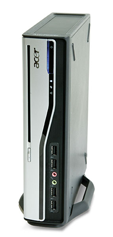Portable Computer Console
March 9, 2008 Computers like the Atari 800, Commodore 64, or Amiga 500 share a special place on my gaming mantle. The specialized sound and video hardware can make all the difference when experiencing old and new games alike. However, there are times when they really begin to show their age. Of course, being old is never a problem here, but it is when you’re trying to mesh the old with the new. Take the Atari 2600 console, for example. I just recently installed a nice little hardware upgrade which provides the console with the technology to output a composite or s-video signal. The composite signal looks good on a normal television; the colours are clear and sharp and the signal is strong and healthy. When IÂ plug the cable into my high-definition television, suddenly things start to go very wrong.This doesn’t necessairily mean it’s the console’s fault or a poorly installed hardware mod. In this case, it’s probably something the television is doing. Most high-definition televisions have electronics which pre-process the video signal before it is sent to the display. These processes, or filters, can help clean up the signal or enhance it to make it look good on your high-definition screen. The hardware is normally tuned to your specific display, so the number and quality of the filters can vary from television to television. One of the downsides to this technology can be increased blurring, shifting, or muted color when you’re trying to view a low-definition signal, or a signal that the hardware deems to be unclean or poorly formed. The filters kick in to help fix the problem but it really only serves to exacerbate the situation. Some of the filters seem to designed for higher resolutions, and only serve to degrade the visual quality of the lower-definition signal coming from your console.
Computers like the Atari 800, Commodore 64, or Amiga 500 share a special place on my gaming mantle. The specialized sound and video hardware can make all the difference when experiencing old and new games alike. However, there are times when they really begin to show their age. Of course, being old is never a problem here, but it is when you’re trying to mesh the old with the new. Take the Atari 2600 console, for example. I just recently installed a nice little hardware upgrade which provides the console with the technology to output a composite or s-video signal. The composite signal looks good on a normal television; the colours are clear and sharp and the signal is strong and healthy. When IÂ plug the cable into my high-definition television, suddenly things start to go very wrong.This doesn’t necessairily mean it’s the console’s fault or a poorly installed hardware mod. In this case, it’s probably something the television is doing. Most high-definition televisions have electronics which pre-process the video signal before it is sent to the display. These processes, or filters, can help clean up the signal or enhance it to make it look good on your high-definition screen. The hardware is normally tuned to your specific display, so the number and quality of the filters can vary from television to television. One of the downsides to this technology can be increased blurring, shifting, or muted color when you’re trying to view a low-definition signal, or a signal that the hardware deems to be unclean or poorly formed. The filters kick in to help fix the problem but it really only serves to exacerbate the situation. Some of the filters seem to designed for higher resolutions, and only serve to degrade the visual quality of the lower-definition signal coming from your console.
Wouldn’t it be nice to have crisp, clean, beautiful colours shown on your high-definition television? Of course it would, and there are options available to you. One option is to support the services which provide these games to you on your high-definition console. The Nintendo Wii and Microsoft’s Xbox 360 both provide on-line shops for you to buy these titles. However, when compared to the sheer number of classic games available, the companies simply do not have the money, desire, or the ability to offer anything more than the most popular titles for the most popular consoles. Sometimes I like to play games which will never be discussed in the forums, and I would bet one of my cats that these titles will never see the light of day through these services. It’s not a case of simply choosing one over the other; I support these services whenever I see a title I would enjoy playing, but the release cycles are too few to satisfy my gaming needs.
The solution for me was the personal computer and hardware emulation. I had specific requirements for the physical size, number of available ports, and driver compatibility. Those were the three biggies. I could ramble on about the time I spent searching and testing different machines, but I won’t bore you with that. No, you’re reading this blog for results. The machine I chose to go with is the AcerPower 1000 computer. It’s smaller than your average DvD player, performs well using under low power consumption, and runs very quietly. It also has oodles of USB ports for lot’s of expansion possibilities. I needed the machine to support at least two joysticks (along with the USB keyboard and mouse), and I wanted those ports easily accessible. The AcerPower has four high-speed ports right in the front of the machine which was perfect for my needs. It also has 3D support using an nVidia GeForce 6150 chipset and full environmental audio; I tested the graphics chipset with the Ion Storm’s Deus Ex and it ran very well at 1024×768. So long as the software can support one of your television’s video modes, everything should work out alright.
Categories: Hardware
No Comments »







No Responses to “Portable Computer Console”
Care to comment?